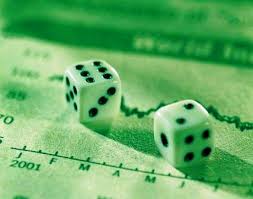Sunday, July 4, 2010
Should Investors Bet on Rising Risk?
So this is the way the quarter ends: not with a whimper but with a bang.
First investors had their hair set on fire by the "flash crash" of May 6. Then came the jolt of June, as stocks lost another 5.2% and finished the month with five down days in a row.
As usual, the markets made a monkey out of anyone who had been certain about what had to happen next.
Europe is in worse shape than the U.S., said the consensus this spring—and, right on cue, European stocks outperformed the U.S. market sharply in June. Treasury securities, legions of experts declared earlier this year, were doomed to lose money—and promptly boomed, with long-term U.S. government bonds gaining 8% last month and 23% year-to-date. And even as the housing market faltered again, real-estate stocks did slightly better than U.S. equities overall.
Meanwhile, volatility burst back onto the scene. The widely followed "fear gauge"—the CBOE Volatility Index, or VIX—nearly tripled from April to May, after a long decline from the jagged days of late 2008 and early 2009. After falling back in early June, the VIX spiked again in the final days of the month.
Investors have taken note. On June 30, according to IndexUniverse.com, iPath S&P 500 VIX Mid-Term Futures, which tracks futures contracts on the volatility index, was the fastest-growing exchange-traded product in the country. It grew by 25% on that day alone, taking in $128 million from investors hoping to profit from the spike in turbulence. The iPath instrument has returned 9% over the last month and was up 46% in the second quarter, according to Morningstar, the investment-research firm.
Meanwhile, although figures aren't in yet for June, trading activity by clients at Charles Schwab was up 17% in May from April—which, in turn, was up 12% over March. At TD Ameritrade, the average number of daily transactions has grown at about 14% over the same period. "There are more people trading," says Jay Pestrichelli, a managing director at TD Ameritrade, "and there are more people trading options to try to take advantage of volatility."
Before you join the crowd trading on turbulence, there are a few things you should know.
First, while volatility provides a close mirror image of current returns, it is a poor forecaster of future returns. Robert Engle, a finance professor at New York University who shared the 2003 Nobel Prize in economics for his research on volatility, warns that "there really isn't any predictability in that direction." He explains, "Even though volatility tends to be high in bad markets, that doesn't mean the market is going to keep going down—it just means the market has been going down."
Prof. Engle adds that periods of high—or low—turbulence don't persist indefinitely. "When you're in a stormy period, there is a tendency for the storm to end," he says. "But it's not a very strong effect, and it can take a long and uncertain time." It is possible to forecast volatility "in general," says Prof. Engle, "but there's a lot of uncertainty around those forecasts."
In short, "volatility has a volatility of its own," says finance professor Robert Schwartz of Baruch College at the City University of New York. That is precisely why the prices of the various products based on the VIX vary drastically over time.
Just as you are likely to add earthquake coverage to your insurance policy after—but not before—the ground has been shaken, the VIX typically goes up as stocks go down, and vice versa.
Investors have a chronic habit of chasing any asset that rises and fleeing it when it falls, even though they should become less willing to buy into whatever grows more expensive and more eager to pick up whatever gets cheaper. (Just think of how much happier you were to hold stocks three years ago than you are today.) The surging interest in trading on turbulence seems to be working much the same way. As volatility has become more costly to "own," more people want to buy it. When it was cheaper, it went begging.
There is little doubt that adding some volatility insurance to your portfolio is a good idea. But the time to do so is when most other investors have no interest in it—not when it is in the midst of a sudden burst of popularity. If you want to capitalize on volatility, wait until markets are calm, not stormy, and the prices of the various VIX products come down. Right now, Prof. Engle says, "it's insurance, but it's gold-plated insurance."

This post is brought to you by: ESG-Network
e-Students Guide is a free education portal for students providing free education articles, resources, career counseling and latest jobs. Follow Us at Twitter, Facebook
Should Investors Bet on Rising Risk?
2010-07-04T05:01:00-07:00
ESG-Network
Guidance|Investment|learning|Smart Investor|
Subscribe to:
Post Comments (Atom)

